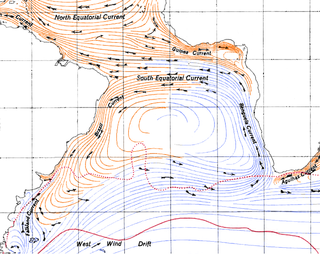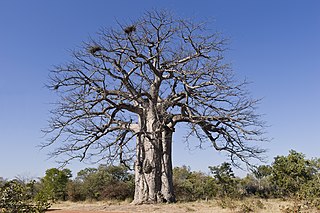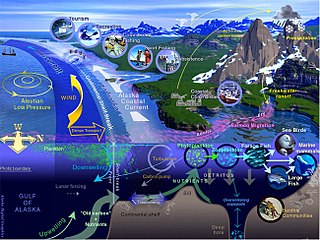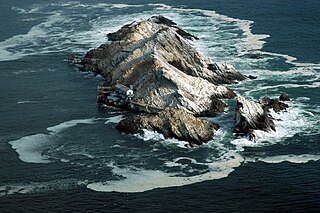Related Research Articles

Upwelling is an oceanographic phenomenon that involves wind-driven motion of dense, cooler, and usually nutrient-rich water from deep water towards the ocean surface. It replaces the warmer and usually nutrient-depleted surface water. The nutrient-rich upwelled water stimulates the growth and reproduction of primary producers such as phytoplankton. The biomass of phytoplankton and the presence of cool water in those regions allow upwelling zones to be identified by cool sea surface temperatures (SST) and high concentrations of chlorophyll-a.

Fishery can mean either the enterprise of raising or harvesting fish and other aquatic life; or more commonly, the site where such enterprise takes place. Commercial fisheries include wild fisheries and fish farms, both in freshwater bodies and the oceans. About 500 million people worldwide are economically dependent on fisheries. 171 million tonnes of fish were produced in 2016, but overfishing is an increasing problem — causing declines in some populations.

The terms international waters or trans-boundary waters apply where any of the following types of bodies of water transcend international boundaries: oceans, large marine ecosystems, enclosed or semi-enclosed regional seas and estuaries, rivers, lakes, groundwater systems (aquifers), and wetlands.

Heaviside's dolphin, is one of four dolphins in the genus Cephalorhynchus. The small cetacean is endemic to the Benguela ecosystem along the southwest coast of Africa.

The Benguela Current is the broad, northward flowing ocean current that forms the eastern portion of the South Atlantic Ocean gyre. The current extends from roughly Cape Point in the south, to the position of the Angola-Benguela front in the north, at around 16°S. The current is driven by the prevailing south easterly trade winds. Inshore of the Benguela Current proper, the south easterly winds drive coastal upwelling, forming the Benguela Upwelling System. The cold, nutrient rich waters that upwell from around 200–300 m (656–984 ft) depth in turn fuel high rates of phytoplankton growth, and sustain the productive Benguela ecosystem.

Iona National Park is the largest national park in Angola. It is situated in the Southwestern corner of the country, in Namibe Province. It is roughly bound by the Atlantic Ocean to the West, an escarpment to the East that marks the beginning of the interior plateau, the Curoca River to the North, and the Cunene River to the South. It is about 200 kilometres (120 mi) south of the city of Namibe and covers 5,850 square miles (15,200 km2) sq. miles.

Large marine ecosystems (LMEs) are regions of the world's oceans, encompassing coastal areas from river basins and estuaries to the seaward boundaries of continental shelves and the outer margins of the major ocean current systems. They are relatively large regions on the order of 200,000 km² or greater, characterized by distinct bathymetry, hydrography, productivity, and trophically dependent populations. Productivity in LME protected areas is generally higher than in the open ocean.
Cormac Cullinan is a practising environmental attorney and author based in Cape Town, South Africa. He is a director of the leading South African environmental law firm, Cullinan & Associates Inc, and director of the Wild Law Institute, a non-profit organisation that advocates for Rights of Nature. A former commercial lawyer, he has practiced, taught and written about environmental law and policy since 1992, and has worked in more than 20 countries.
The South East Atlantic Fisheries Organisation (SEAFO) is an organization that maintains controls over fishing and fishing related acts in the Southeastern Atlantic Ocean.

Mercury Island is a small rocky island off The Diamond Coast, Namibia. Despite its small size it is recognised by BirdLife International and other global conservation groups as an Important Bird Area (IBA) for its important coastal seabird breeding.
The Port Management Association of Eastern and Southern Africa (PMAESA) is a non-profit, inter-governmental organization made up of Port Operators, Government Line Ministries, Logistics and Maritime Service Providers and other port and shipping stakeholders from the Eastern, Western and Southern African and Indian Ocean regions.
The Leibniz-Zentrum für Marine Tropenforschung (ZMT) in Bremen, Germany is the only scientific institute in Germany that exclusively investigates tropical and subtropical coastal ecosystems and their significance for nature and humans in an interdisciplinary approach. The mission of ZMT is to provide a scientific basis for the protection and sustainable use of tropical coastal ecosystems by conducting research, capacity development and consulting activities in close cooperation with national and international partners in the tropics. Since its launch in 1991, ZMT has also developed a huge network of research and political partners within the tropics and worldwide, including more than 800 alumni. The institute offers a broad range of research infrastructure, including its own scientific diving centre and laboratories such as the Marine Experimental Ecology Facility (MAREE). ZMT also hosts the Future Earth Coasts (FEC) office, a global network of experts investigating the drivers of global change in coastal zones.

Nils Daniel Bang was a South African oceanographic scientist who was a pioneer in the study of the fine structure of coastal upwelling systems. In March 1969, Bang initiated, planned and executed South Africa's first truly multi-ship oceanographical research operation, the Agulhas Current Project, along the current's length. Although the research was conducted on a limited budget and with rudimentary equipment, Bang's studies using thousands of closely spaced bathythermograph readings were later corroborated by satellite imagery and airborne radiation thermometry.

Western Indian Ocean Marine Science Association (WIOMSA) is a regional professional, non-governmental, non-profit, membership organization, registered in Zanzibar, Tanzania. The organization is dedicated to promoting the educational, scientific and technological development of all aspects of marine sciences throughout the region of Western Indian Ocean, with a view toward sustaining the use and conservation of its marine resources. The association has about 1000 individual members as well as about 50 institutional members from within and outside the region.

The marine ecoregions of the South African exclusive economic zone are a set of geographically delineated regions of similar ecological characteristics on a fairly broad scale, covering the exclusive economic zone along the South African coast.
The marine protected areas of South Africa are in an area of coastline or ocean within the exclusive economic zone (EEZ) of the Republic of South Africa that is protected in terms of specific legislation for the benefit of the environment and the people who live in and use it. An MPA is a place where marine life can thrive under less pressure than unprotected areas. They are like underwater parks, and this healthy environment can benefit neighbouring areas.

Temperate Southern Africa is a biogeographic region of the Earth's seas, comprising the temperate waters of southern Africa, where the Atlantic Ocean and Indian Ocean meet. It includes the coast of South Africa and Namibia, and reaches into southern Angola. It also includes the remote islands of Amsterdam and Saint-Paul, to the east in the southern Indian Ocean.
The Biodiversity of South Africa is the variety of living organisms within the boundaries of South Africa and its exclusive economic zone. South Africa is a region of high biodiversity in the terrestrial and marine realms. The country is ranked sixth out of the world's seventeen megadiverse countries, and is rated among the top 10 for plant species diversity and third for marine endemism.

The Angola - Benguela front (ABF) is a permanent frontal feature situated between 15° and 17°S off the coast of Angola and Namibia, west Africa. It separates the saline, warm and nutrient-poor sea water of the Angola Current from the cold and nutrient-rich sea water associated with the Benguela Current.
The Rocherpan Marine Protected Area is a small coastal conservation region on the West Coast of the Western Cape province, in the territorial waters of South Africa. It is about 25 km north of Velddrif on the road to Elands Bay, north of Dwarskersbos.
References
- Hempel, G.; O'Toole, M; Sweijd, N, eds. (2008). Benguela Current of Plenty. A history of international cooperation in marine science and ecosystem management. Cape Town, South Africa: Benguela Current Commission. ISBN 978-0-620-42211-6.
- O'Toole, M.J.; Shannon, V.; de Barros Neto, V.; Malan, D. (2001). "Integrated Management of the Benguela Current Region – a framework for future development". In B. von Bodungen; R.K. Turner (eds.). Science and Integrated Coastal Management. Dahlem University Press.